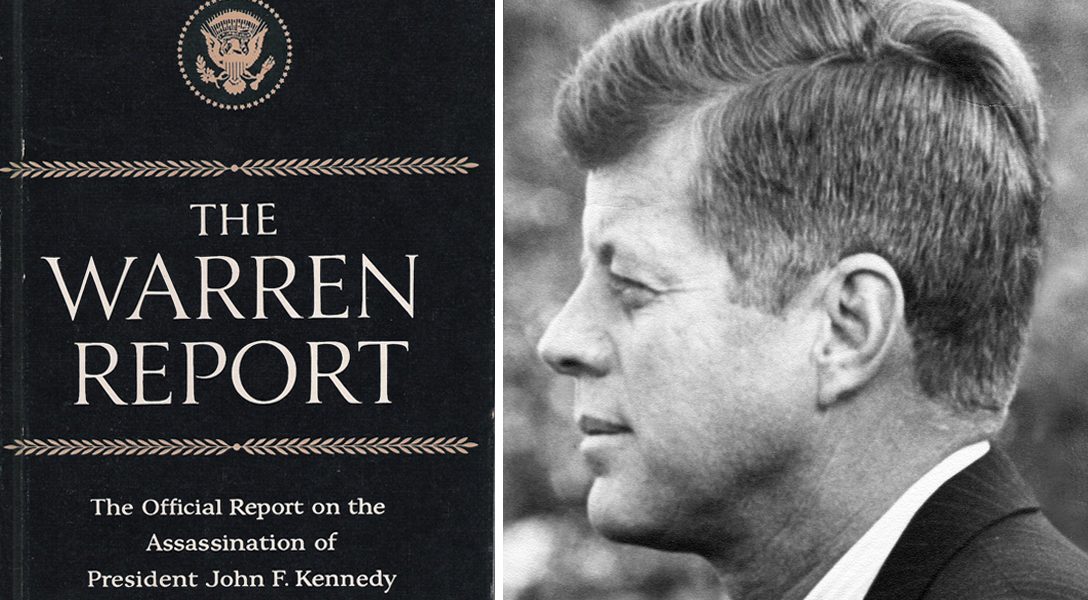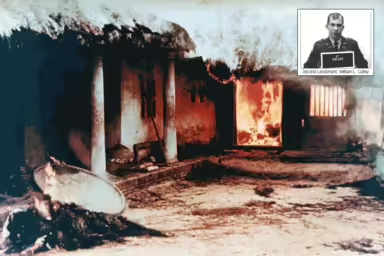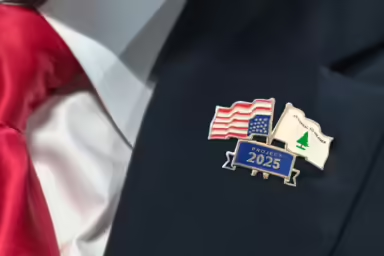JFK Assassination: The Tell-Tale Brain
Keeps on Telling — What Is It Saying?
How the most inconvenient piece of evidence in the investigation of the assassination of President John F. Kennedy continues to be suppressed, and in the most amazing ways.
Researchers are now analyzing newly released documents concerning the assassination of President John F. Kennedy, but many extraordinary facts have been in plain sight for decades — and yet unseen. This report concerns one of those facts, and how, to this day, the story around it is being concealed.
The Tell-Tale Brain
.
Within minutes of Kennedy’s murder, witnesses were pointing at areas where they said they heard shots — and many pointed to a place in front of Kennedy. But, according to the official version of events, there was only one shooter, and he fired from behind. What did the body show? What did the autopsy report say?
More interesting is what it did not say.
Autopsy reports are supposed to contain all information relevant to the cause of an individual’s death — as well as those details that are not related to the death. As Dr. Alan R. Moritz put it in the American Journal of Clinical Pathology in 1956:
In the protocol of a medicolegal autopsy, it is better to describe 10 findings that prove to be of no significance than to omit one that might be critical.
An autopsy report should contain all findings visible to the naked eye and measurable. Kennedy’s autopsy report includes various details, both relevant and irrelevant. You will find in it meticulous notes on a variety of things: the width of each pupil … the circumference of each heart valve … the condition of the teeth … the location of each tear into the scalp … the length and location of fracture lines in the skull …
And an extensive description of damage to one part of the brain. Note: only one part.
But since Kennedy died of a bullet (or bullets) to his head, you might expect that all parts of his head would be described.
Then how strange it is that Navy Commander James Humes, MD — the lead pathologist who performed the autopsy and wrote the report — left out any mention of what has become one of the most hotly debated subjects in the medical evidence, one that relates directly to the still-unsettled question of where the shots came from. You will not find one word about it in the report, nor in Humes’s detailed testimony before the Warren Commission, which investigated the assassination in 1964.
This omitted part of the brain is the cerebellum — the pink shape in the otherwise blue picture below. Some consider it a separate organ.

The omission of any gross description of the cerebellum in an autopsy report on a victim shot in the head is most irregular. To understand its significance, we ask you to please endure a short anatomy lesson:
Cerebellum. Rhymes with antebellum. Not to be confused with the larger part of the brain above it, the cerebrum. The former ends in “bellum” and the latter ends in “brum.”
Both cerebellum and cerebrum were greatly damaged according to the Dallas doctors who examined Kennedy.
But Humes et al. reported only damage to the cerebrum (the blue part in the above picture).
The significance of cerebellar damage is what it says about specific skull damage — and what that damage could mean about the direction of the shot. According to the official narrative, only one bullet hit Kennedy in the head, a bullet that came from above and behind the president. But this is inconsistent with the damage observed, as will be explained below.
The Tell-Tale Bones
.
Humes said something else in the autopsy report that does not make sense. He explained that three bone fragments were brought to the autopsy room late in the evening which, he said, “in aggregate roughly approximate the dimensions of the large defect described above.”
Meaning all major bone fragments were accounted for. Meaning none were missing. Meaning the only great hole in the skull was the one on top.
The problem is, another fairly large fragment was found later and turned in to the FBI on November 25, 1963, after the autopsy. It was 7 by 5.5 centimeters (almost 3 by 2 inches). (Called the “Harper fragment,” named after Billy Harper, who found it.)
Where would this good-sized piece of the puzzle go if the hole on top could already be filled with the bone fragments brought earlier?
By the time Humes testified before the Warren Commission in March 1964, it seems reasonable to suppose that he had been made aware of the Harper fragment — yet he said nothing about it.
On the other hand, he did revise what he said in his autopsy report: “The three pieces could be put together roughly to account for a portion of this defect.” [Emphasis added.] Asked about how much remained unaccounted for, Humes estimated it to be one-quarter.
Did this revision come about because of the Harper fragment?
The Harper fragment was about the same size as the hole in the back of the head reported by the Dallas doctors. (The chief pathologist at Methodist Hospital in Dallas, who examined it before it was turned over to the FBI, said the fragment came from the lower part of the back of the skull.)
Where the Harper fragment came from is still being debated, but what is not debatable is this: In his autopsy report, Humes did not acknowledge any good sized piece of still-missing bone, not until after the Harper fragment was found.
The Parkland doctors, including the hospital’s chief of neurosurgery, William Kemp Clark, MD, told the Warren Commission that they did not examine Kennedy’s entire head, but they did look into a large hole in the back, a place where both scalp and bone were missing. They saw destruction of the right cerebrum (blue part in the picture) — and the cerebellum (pink part of the picture).
Unfortunately, Clark was not asked about the lower border of the hole he saw — but if damaged cerebellum was visible inside the skull and leaking from it, then the skull damage had to extend to the lower part of the right rear of the head.
Clark, who had the closest look (and let’s remember that the skull and brain were his specialty) described “a large, gaping wound in the right posterior part, with cerebral and cerebellar tissue being damaged and exposed.” In his hospital notes, he reported “considerable loss of scalp and bone tissue. Both cerebral and cerebellar tissue were extruding from the wound.” [Emphasis added.]
Perhaps the most illuminating part of his testimony came in response to the question of whether this large wound in the back of the head was an entrance or an exit. Clark said, “It could be an exit wound, but I felt it was a tangential wound.” (By “tangential” he said he meant “striking an object obliquely” from the side.)
If it was an exit wound, this would of course indicate a shooter somewhere in front. If tangential, it would place the shooter off to the side. (Films show JFK facing the front, leaning forward, with his head turned slightly to his left.) But the government story is that the shooter was above and behind Kennedy, on the sixth floor of the Texas Book Depository Building.
(The Supplementary Autopsy Report, which describes microscopic findings, does mention that a slice of cerebellum was studied along with several other specimens, and that all of them reflected damage due to a bullet. But this provides no indication of the extent of the damage.)
Big Hole Versus Small Hole
.
The cerebellum wouldn’t even have been visible, let alone free to leak out, as reported by the Dallas doctors, were it not for the great fist-sized hole (one doctor said it was between 5 and 7 centimeters in diameter) where both bone and scalp were actually missing — in the back of the head.
But the autopsists reported only a small hole (6 x 15 millimeters) back there.

As you can see, Commission Exhibit 386, above, shows no “large gaping wound” in the back of the head. (The autopsy doctors and official photographers say they took pictures of the hole in the bone, but those and other photographs are missing.)
The Mysterious Migrating Hole
.
Apparently in response to public skepticism, more official investigations followed. And “blue ribbon” panels of distinguished doctors were formed — the Clark Panel in 1968 and the House Select Committee on Assassinations (HSCA) in 1979. They revised the reported evidence. Allegedly basing their conclusions on X-rays and photographs, they said the small hole was four inches higher than the last reported location.
Four inches higher? This is difficult to understand since Humes et al. located the small wound in relation to a specific, fixed landmark: a bump low in the back of the skull. They said the entry wound was just above this hard-to-miss bump.
But, as if to nail down this new location, they said an X-ray showed a round slice of a bullet fragment embedded in the skull at this new location, with a diameter of 6.5 millimeters.
This bullet fragment — not seen earlier — happens to be the exact diameter of the kind of bullet allegedly used by Lee Harvey Oswald.
How did that happen? The chief radiologist and others, who presumably reviewed the same skull X-rays three years earlier, did not see any such large round fragment, and yet it now shows up as clearly as a candle in a pumpkin. According to Humes, the largest fragment seen on X-ray was a slender, stick-like 7 x 2 millimeters, which he extracted.
This does not seem to be a case of different interpretations of the same features. It is more a matter of actually seeing different features altogether.
Below are two diagrams side by side that show the two versions of the entry wound’s location — one low in the skull, no higher than the ears, and the other near the top of the head. (Note: because of all of the revisions, including those by the autopsists, we cannot assume a wound was actually where the autopsists placed it; we only know they were fairly precise in describing where the alleged entrance wound was.)

Here is another complication with the original location: Army experiments on skulls performed in 1964 showed that if a bullet entered that low on the skull, it would have exited from Kennedy’s face. Yet no bullet exited his face.
In his book, Reclaiming History: The Assassination of President John F. Kennedy (2007), the late Vincent Bugliosi said that the Parkland doctors could not possibly have seen any large hole in the back of the head — and that they could not possibly have seen any cerebellum either. In his words, from page 404:
Indeed, with the entry wound to the President’s head being as high up as it was, it would have been virtually impossible for the cerebellum, in the lower part of the brain, to have been damaged, at least by a bullet.
In other words, small hole in upper skull = higher bullet path into and out of head = no small or large hole in lower skull = no cerebellar damage = shooter from above and behind, which was the official story. Bugliosi repeatedly tried to give the false impression of an undamaged cerebellum, on pages 404 and 405:
There isn’t one word in the report indicating that any part of the cerebellum was missing or even lacerated.
It bears repeating that the autopsy report only mentioned damage to the cerebrum, not the cerebellum.
A false impression because Bugliosi failed to tell the reader that the condition of the cerebellum wasn’t described — at all. (Or that the Supplementary Report, which did mention it, reported that a slice examined under the microscope revealed bullet-related damage.)
Physicians in Dallas say they saw — with their own eyes — badly damaged cerebellum oozing from a hole in visible bone in the lower part of the skull. Those who promote the official narrative say the cerebellum was just fine. Who are we to believe?
An Insight From Cyril Wecht, MD, JD
.
The distinguished forensic pathologist Cyril Wecht, who was also a member of the HSCA Medical Panel, apparently did not notice the missing cerebellum in the autopsy report. A critical essay he wrote does refer to two omissions — the adrenal glands and the left cerebrum, omissions which, to me, are not as significant as the cerebellum.
But, at the end, Dr. Wecht wrote something very interesting which may explain all of the omissions: “If they [the autopsy doctors] were told by their military superiors to make the omissions and obeyed that order … it becomes comprehensible why civilian medico-legal experts were excluded from the autopsy — [because] they could not have been controlled in this way.”
“A Critique of President Kennedy’s Autopsy.” Excerpt
[…]
The official autopsy report contains two omissions which cast a shadow over the whole proceeding. First the failure to mention the adrenal glands, either grossly or microscopically … I should stress that these glands played no role whatsoever in President Kennedy’s death and from that standpoint have no significance …
Another deficiency in the overall report (and one directly associated with the murder) concerns the examination of the president’s brain. A reading of the supplementary autopsy report on the brain examination discloses that the entire brain was not cut into coronal sections (16H987). Although one small section was excised from the front on the left side, the description indicates that no examination of the brain’s left side was performed. This is appalling. We cannot know what injuries were present in the left cerebral hemisphere if no examination was made. No competent forensic pathologist would examine only half a brain, particularly in a case where it had been injured by one of more bullets.
Either way we consider these deficiencies, the picture is not reassuring. If the military pathologists on their own decided not to examine the adrenal glands and the left cerebral hemisphere, then they are to be soundly condemned … If they were told by their military superiors to make the omissions and obeyed that order, then two things follow: (1) The pathologists and their report are totally discredited, and (2) it becomes comprehensible why civilian medico-legal experts were excluded from the autopsy — they could not have been controlled in this way. [Appendix D, Six Seconds in Dallas (Bernard Geis Associates, 1976, paperback version) pp.364-365]
[Cyril H. Wecht, MD, LLB, is chairman of the advisory board of the Cyril H. Wecht Institute of Forensic Science and Law, Duquesne University School of Law; Coroner for Allegheny County, Pennsylvania.]
In a follow-up article, we will show how the stories of the Dallas doctors were changed in ways no more convincing than the contrived narrative of the ever-moving small hole.
RELATED: Kennedy Assassination: Evidence Seen by JFK’s Doctor Suppressed
RELATED: Navy Doctor: Bullet Found in JFK’s Limousine, and Never Reported
RELATED: Disinformation Part 1: How to Control an Internet Forum
Related front page panorama photo credit: Adapted by WhoWhatWhy from brain (DrugAbuse.gov).



